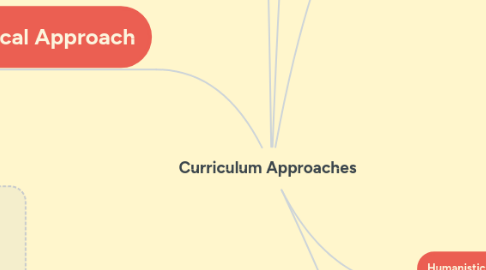Curriculum Approaches
by Patty Tenezaca

1. 3. MANAGERIAL APPROACH
1.1. 1. considers the school as a social system.
1.2. 2. Educators who rely on this approach plan the curriculum in terms of programs, schedules, space, resources and equipment and personnel.
1.3. 3. In 1900, a large number of innovative plans were combined that included a curriculum and instruction that focused on individualization, not qualification, the grouping of classrooms.
1.4. 4. This approach focuses more on the administrative and supervisory aspects, especially on the organizational and implementation process.
2. Critical Approach
2.1. It includes music and art that are essential to developing critical thinking skills.
2.2. Has 5 curriculum orientations between the teacher, student, and the subject matter
2.2.1. 1. Academic Rational- It is the role of the teacher to cover the content. 2.Cognitive Processes- The teacher guides the students in problematic situations. 3. Personal Relevance- Curriculum builds on students' interests. 4. Social Perspective: focuses on controversial issues and encourages students to solve them. 5. Technological orientation: it uses a scientific approach when it is planned.
3. 5. SYSTEMS APPROACH TO CURRICULUM
3.1. This approach includes the processes of development, design, implementation and evaluation.
3.2. It was originally developed by social scientists in the 1950s and 1960s.
3.3. This approach emphasizes the priority of students, the collection and analysis of data, self-control and inspection, collaboration, communication, cooperation and responsibility.
4. 1. What Is?
4.1. 1. The role of the learners, the teache. 2. It also includes the goals and objetives of the curriculum.
4.2. Shows the viewpoint of curriculum development and desing.
5. 2. ACADEMIC APPROACH
5.1. * Referred to as the traditional. *Analyze and synthesize the main positions, trends and concepts of the curriculum.
5.2. * It is based on the philosophical works of John Dewey, Henry Morrison and Boyd Bode. It became popular in the 1930s and 1950s.
5.3. After 1950 the curriculum focused on the structure of the discipline and qualitative methods.
6. Humanistic Approach
6.1. They are too rigid and too technocratic.
6.2. This humanistic view is rooted in the progressive philosophy and the child-centered movement of the early 1900s.
6.3. Was first spearheaded by John Dewey, Charles Judd and Francis Parker.
6.4. Developed progressive methods of teaching based on the child’s natural development and curiosity.


